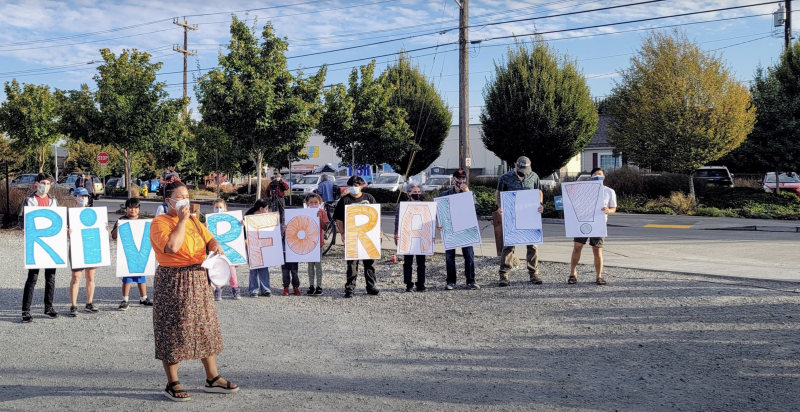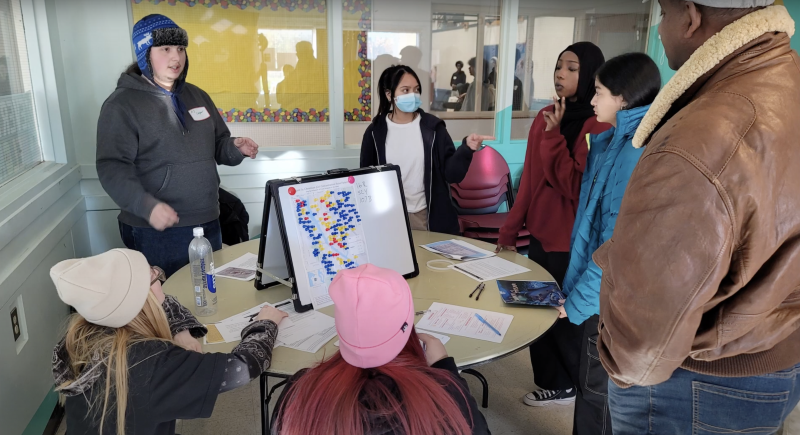13 WWU Students Receive Award in EPA's 2023 Environmental Justice Video Challenge
A group of 13 Western Washington University students – as well as two students from the University of Washington – received an honorable mention award in Phase 2 of the Environmental Justice (EJ) Video Challenge for Students through the United States Environmental Protection Agency. (EPA)
Due to the fact that a number of communities are faced with greater environmental exposures and health risks as a product of inequitable environmental policies and access to decision-making processes, the EPA established the video challenge to encourage students to enhance communities’ capacity to address these concerns.
There were two phases of the video challenge: Phase 1, which had students create videos showcasing innovative approaches to characterize and identify environmental justice issues in a community using data and available tools. The winners of Phase 1 were announced on July 28, 2022. Phase 2 of the challenge focuses on enhancing the communities’ capacity to address issues of environmental justice that were identified in Phase 1 of the challenge. In this phase, students worked with community organizations to create strategies that demonstrate community engagement and advocacy regarding the issue.
“Phase 1 was mostly focused on, ‘What’s the issue?’ and Phase 2 was focused on, ‘What are you doing about it? What strategy that you are proposing will improve the capacity of community organizations to come and address this problem?’” said Drew Slaney, an environmental studies graduate student at Western who worked on submissions in both phases.
Slaney, along with his fellow graduate student Allison Hayes and with the assistance of Western Professor of Environmental Policy Troy Abel, won third place in Phase 1 with their submission titled “Interdisciplinary Mapping for Environmental Justice” addressing the industrial impacts of air pollution in South Seattle communities. The video detailed how moss collection samples in these communities had high concentrations of arsenic, chromium and lead: Three metals that are associated with causing cancer in the neighborhoods of South Park and Georgetown. The prize for this phase was $6,000.
The winners for Phase 2 of the challenge were announced on May 9, 2023, with the group including Western students earning an honorable mention award. The students in the winning group were Isebella Bergsma, Cianna Bergsma-Galarosa, Christopher Castro, Algere (AJ) Cooper, Guadalupe Sanchez, Alexis Sorm, Randall Thall, Wala Abdin, Montana Siddle, Nikki Araya, Naythan Ramos, and Issaiah Cummins. The two University of Washington students were Jenny Meyer and Rudi Mondrogon. Slaney was the lead video creator for the Phase 2 submission.
The three-minute-long video submission, “DRIVERS4EJ,” highlighted efforts by members of the Duwamish Valley Youth Corps, Western, and the University of Washington to address the air pollution disparities in South Seattle highlighted in the Phase 1 submission. Students generated dialogue with community members through neighborhood association meetings and workshops to help identify the sources of pollution in the area to community members.
The honorable mention award qualified for a $12,500 prize. $10,000 of this went to the collaborating community organization, the Duwamish Valley Youth Corps, and the rest was split among the participating students.
The driving force behind the contest was to really get to promote the work of the Duwamish Valley Youth Corps, and the students involved in that.
WWU graduate student Drew Slaney
“The students in the group were alumni of the Duwamish Valley Youth Corps and had previously worked on the moss sampling and collection project that Troy was working on,” Slaney said. “It’s one thing to do the research process and sampling, but it’s another thing to ask, ‘Well, what’s next? How do you fire up the community to really start talking about this and addressing the issue?’”
Slaney said that Western’s Video Services helped the group a lot in terms of creating and producing the video itself.
“The driving force behind the contest was to really get to promote the work of the Duwamish Valley Youth Corps and the students involved in that,” Slaney said. “Showcasing it was super cool. But also to provide some funding for them and for their work. That’s awesome.”
But the work doesn’t stop here.
Following the creation and production of DRIVERS4EJ, Abel has now implemented some of the research and curriculum from the project into his Environmental Policy Analysis class at Western.
During one class period, Abel had students map the spatial element of air pollution in the Duwamish Valley in Seattle. Students used thumbtacks to locate different areas that were a hotspot for air pollution on the maps and then located the places that were most affected.
“My group and I are also doing a policy analysis on the Climate Commitment Act for some of the work we are doing this quarter,” Western student Mallory Ekman said.
Slaney said that despite his efforts for both of the projects, he wants to highlight the work that the students in the project are doing and continue to provide education about the issue.
“They are the ones that are bringing it to the community. They’re the ones that are talking to the community and the ones that are truly a part of it. I think that’s the main crux of it all.”
For more information on the EPA’s video challenge, go to https://www.epa.gov/innovation/environmental-justice-video-challenge-students. The Phase 1 submission can be viewed here: https://www.youtube.com/watch?v=IjLrN2OkMYs and the video from Phase 2 can be viewed here: https://www.youtube.com/watch?v=o7C4f86dc9k&t=83s.

